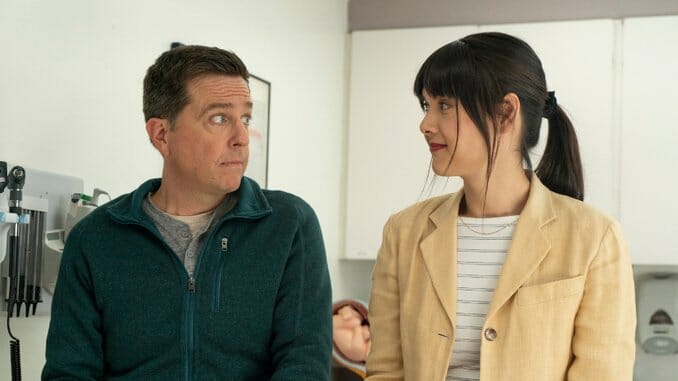Platonic Friendship, Loneliness and Found Family in Together Together

Where in the body do you store the nourishing feeling of company? How do you cultivate a love you can live inside, when that love blossoms within a temporary circumstance? How do you take your loneliness back off the shelf and return it to the center of your kitchen table when a friend may potentially depart? In Together Together, Matt (Ed Helms), a soon to-be father, and Anna (Patti Harrison), his surrogate, are forced to navigate these questions as their friendship grows during Anna’s pregnancy.
Together Together has the qualities of most touching, cheeky indie comedies. It’s 90 minutes, it has a three-act structure that’s segmented in a way which reinforces its themes (each act covers a trimester), there is a revolving door of beloved comedians—Tig Notaro, Julio Torres, Fred Melamed once again nailing the sweet dad schtick (see also: Shiva Baby). But what is especially striking about writer/director Nikole Beckwith’s second feature is its exploration of family, friendship and the interpersonal hoops people jump through to offset the pangs of loneliness.
In the film’s opening scene, Matt’s 40-something tech dude interviews potential candidates for surrogacy and ultimately chooses Anna, a 27-year-old woman. She’s estranged from her religious family due to their judgement towards her high school pregnancy and the baby she subsequently gave up for adoption. Throughout the surrogacy, Matt aspires to nurture and parent a child, build a family of his own and thereby curb the lonesome life that otherwise awaits him. Through her compensation for the surrogacy, Anna will earn the tuition money required to pay for an accelerated college program in Vermont where she can finally earn the degrees she’s dreamed of. What’s supposed to be a mutually beneficial, finite social contract between Matt and Anna becomes increasingly complicated by the loving friendship the pair develop ahead of Anna’s due date.
This friendship, even if it’s the basic premise, is a surprising element of the film. Anna is initially somewhat turned off by Matt’s bumbling, lovable, well-intentioned idiot-man behavior, of which there is plenty. During a joint birthing class, for example, the moderator—a sort of blonde zen warrior—asks Matt and Anna if they’re partners, to which he replies, “No, we are feminists.” He immediately catches himself and grimaces. He’s said the wrong thing. These comic verbal foibles effectively infuse the film with funny flourishes, but they also subtly reinforce the age gap distancing Matt and Anna.
Often, Anna immediately has the language for her wants and discomforts. While baby supply shopping, an employee sighs sympathetically after hearing that Anna is not raising the baby with its father but then quickly pivots and cheers when finding out that Matt is the single dad-to-be. Why the double standard? Anna spots it and names it. She is cogent, quick and unabashed. In contrast, Matt—who learns about braiding hair and using tampons because of Anna’s guidance—often seems to be straining for the right words, for the lexicon that will signal to others that he is approachable, emotionally intelligent, worthwhile. In the world of the film, Matt is renowned for an app in which people can scroll just to see pictures of people nearby. Even in his work life, Matt strives to simulate the feeling of human connection for himself and for other people. The app is both the source of his wealth and a signifier of his loneliness, evidence of his 2D proximity to people before Anna becomes a real-life, 3D companion.
-

-

-

-

-

-

-

-

-

-

-

-

-

-

-

-

-

-

-

-

-

-

-

-

-

-

-

-

-

-

-

-

-

-

-

-

-

-

-

-








































